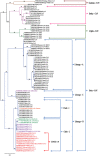An update on the origin of SARS-CoV-2: Despite closest identity, bat (RaTG13) and pangolin derived coronaviruses varied in the critical binding site and O-linked glycan residues
- PMID: 32633815
- PMCID: PMC7361880
- DOI: 10.1002/jmv.26261
An update on the origin of SARS-CoV-2: Despite closest identity, bat (RaTG13) and pangolin derived coronaviruses varied in the critical binding site and O-linked glycan residues
Abstract
The initial cases of severe acute respiratory syndrome coronavirus-2 (SARS-CoV-2) occurred in Wuhan, China, in December 2019 and swept the world by 23 June 2020 with 8 993 659 active cases, 469 587 deaths across 216 countries, areas or territories. This strongly implies global transmission occurred before the lockdown of China. However, the initial source's transmission routes of SARS-CoV-2 remain obscure and controversial. Research data suggest bat (RaTG13) and pangolin carried CoV were the proximal source of SARS-CoV-2. In this study, we used systematic phylogenetic analysis of Coronavirinae subfamily along with wild type human SARS-CoV, MERS-CoV, and SARS-CoV-2 strains. The key residues of the receptor-binding domain (RBD) and O-linked glycan were compared. SARS-CoV-2 strains were clustered with RaTG13 (97.41% identity), Pangolin-CoV (92.22% identity) and Bat-SL-CoV (80.36% identity), forms a new clade-2 in lineage B of beta-CoV. The alignments of RBD contact residues to ACE2 justified? Those SARS-CoV-2 strains sequences were 100% identical by each other, significantly varied in RaTG13 and pangolin-CoV. SARS-CoV-2 has a polybasic cleavage site with an inserted sequence of PRRA compared to RaTG13 and only PRR to pangolin. Only serine (Ser) in pangolin and both threonine (Thr) and serine (Ser) O-linked glycans were seen in RaTG13, suggesting that a detailed study needed in pangolin (Manis javanica) and bat (Rhinolophus affinis) related CoV.
Keywords: COVID-19; RaTg13; SARS-CoV-2; intermediate host; pangolins.
© 2020 Wiley Periodicals LLC.
Conflict of interest statement
The authors declare that there are no conflict of interests.
Figures


References
MeSH terms
Substances
LinkOut - more resources
Full Text Sources
Miscellaneous

